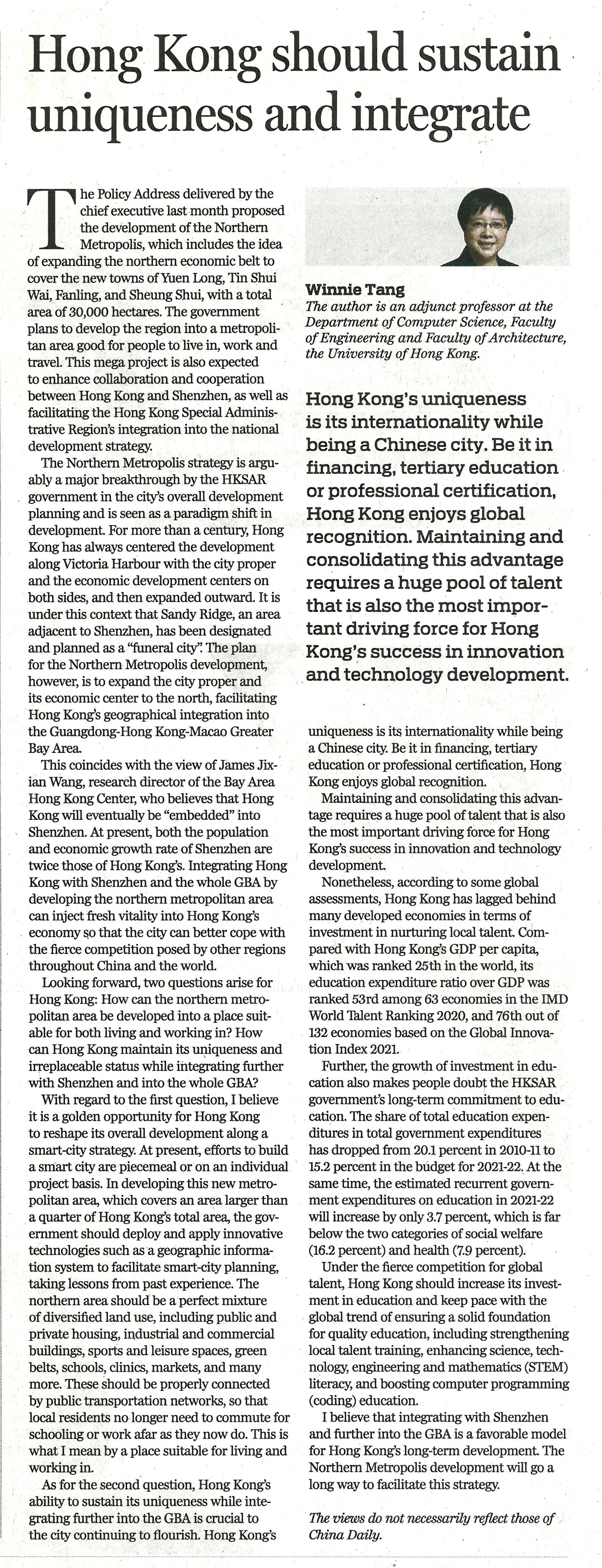網上版請按此

Hong Kong should sustain uniqueness and integrate
The Policy Address delivered by the chief executive last month proposed the development of the Northern Metropolis, which includes the idea of expanding the northern economic belt to cover the new towns of Yuen Long, Tin Shui Wai, Fanling, and Sheung Shui, with a total area of 30,000 hectares. The government plans to develop the region into a metropolitan area good for people to live in, work and travel. This mega project is also expected to enhance collaboration and cooperation between Hong Kong and Shenzhen, as well as facilitating the Hong Kong Special Administrative Region's integration into the national development strategy.
The Northern Metropolis strategy is arguably a major breakthrough by the HKSAR government in the city's overall development planning and is seen as a paradigm shift in development. For more than a century, Hong Kong has always centered the development along Victoria Harbour with the city proper and the economic development centers on both sides, and then expanded outward. It is under this context that Sandy Ridge, an area adjacent to Shenzhen, has been designated and planned as a "funeral city". The plan for the Northern Metropolis development, however, is to expand the city proper and its economic center to the north, facilitating Hong Kong's geographical integration into the Guangdong-Hong Kong-Macao Greater Bay Area.
This coincides with the view of James Jixian Wang, research director of the Bay Area Hong Kong Center, who believes that Hong Kong will eventually be "embedded" into Shenzhen. At present, both the population and economic growth rate of Shenzhen are twice those of Hong Kong's. Integrating Hong Kong with Shenzhen and the whole GBA by developing the northern metropolitan area can inject fresh vitality into Hong Kong's economy so that the city can better cope with the fierce competition posed by other regions throughout China and the world.
Looking forward, two questions arise for Hong Kong: How can the northern metropolitan area be developed into a place suitable for both living and working in? How can Hong Kong maintain its uniqueness and irreplaceable status while integrating further with Shenzhen and into the whole GBA?
With regard to the first question, I believe it is a golden opportunity for Hong Kong to reshape its overall development along a smart-city strategy. At present, efforts to build a smart city are piecemeal or on an individual project basis. In developing this new metropolitan area, which covers an area larger than a quarter of Hong Kong's total area, the government should deploy and apply innovative technologies such as a geographic information system to facilitate smart-city planning, taking lessons from past experience. The northern area should be a perfect mixture of diversified land use, including public and private housing, industrial and commercial buildings, sports and leisure spaces, green belts, schools, clinics, markets, and many more. These should be properly connected by public transportation networks, so that local residents no longer need to commute for schooling or work afar as they now do. This is what I mean by a place suitable for living and working in.
As for the second question, Hong Kong's ability to sustain its uniqueness while integrating further into the GBA is crucial to the city continuing to flourish. Hong Kong's uniqueness is its internationality while being a Chinese city. Be it in financing, tertiary education or professional certification, Hong Kong enjoys global recognition.
Maintaining and consolidating this advantage requires a huge pool of talent that is also the most important driving force for Hong Kong's success in innovation and technology development.
Nonetheless, according to some global assessments, Hong Kong has lagged behind many developed economies in terms of investment in nurturing local talent. Compared with Hong Kong's GDP per capita, which was ranked 25th in the world, its education expenditure ratio over GDP was ranked 53rd among 63 economies in the IMD World Talent Ranking 2020, and 76th out of 132 economies based on the Global Innovation Index 2021.
Further, the growth of investment in education also makes people doubt the HKSAR government's long-term commitment to education. The share of total education expenditures in total government expenditures has dropped from 20.1 percent in 2010-11 to 15.2 percent in the budget for 2021-22. At the same time, the estimated recurrent government expenditures on education in 2021-22 will increase by only 3.7 percent, which is far below the two categories of social welfare (16.2 percent) and health (7.9 percent).
Under the fierce competition for global talent, Hong Kong should increase its investment in education and keep pace with the global trend of ensuring a solid foundation for quality education, including strengthening local talent training, enhancing science, technology, engineering and mathematics (STEM) literacy, and boosting computer programming (coding) education.
I believe that integrating with Shenzhen and further into the GBA is a favorable model for Hong Kong's long-term development. The Northern Metropolis development will go a long way to facilitate this strategy.
Dr. Winnie Tang
Adjunct Professor, Department of Computer Science, Faculty of Engineering; Department of Geography, Faculty of Social Sciences; and Faculty of Architecture, The University of Hong Kong